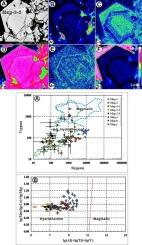Deciphering ore-forming conditions and ore genesis in the Devonian Xierqu iron deposit (East Tianshan, NW China): Insights from in-situ magnetite and apatite geochemistry
IF 3.6
2区 地球科学
Q1 GEOLOGY
引用次数: 0
Abstract
The Xierqu Fe deposit in the Kalatag district offers key insights into Devonian magmatic-hydrothermal iron mineralization within the East Tianshan Orogenic Belt. This study combines detailed microtextural observations, electron probe microanalysis (EPMA), and LA–ICP–MS analyses of magnetite and apatite to decipher the genetic processes and fluid evolution that led to the formation of high-grade Fe ores in the Xierqu deposit. Magnetite mineralization is genetically and spatially linked to quartz diorite porphyry intrusions that were emplaced into volcanic-sedimentary sequences of the Lower Devonian Dananhu Formation. Three magnetite generations are identified: (1) Mag-1 (disseminated) from the prograde skarn stage, characterized by high V (avg. 190 ppm), Cr (avg. 504 ppm), and low Ni/Cr ratios (avg. 0.08), indicative of a high-temperature magmatic-hydrothermal origin; (2) Mag-2 (banded) from the retrograde skarn stage, showing transitional Ni/Cr (avg. 1.57) and moderate V depletion (avg. 92 ppm), reflecting magmatic-hydrothermal interaction; and (3) Mag-3 (massive) from the retrograde skarn stage, marked by hydrothermal signatures (Ni/Cr > 5, V < 73 ppm) and oscillatory zoning linked to fluctuating oxygen fugacity (fO₂) and fluid-rock interaction. Systematic Sn increases (2.2–19.2 ppm) and V/Cr decreases from Mag-1 to Mag-3 record progressive oxidation during retrograde skarn alteration, driven by external oxygen influx and hematite coexistence. Apatite geochemistry further constrains fluid evolution. Retrograde skarn apatite (Apt-1) exhibits high F/Cl (avg. 24.4), negative Eu anomalies (Eu/Eu* = 0.07–0.33), and elevated Sr/Y (avg. 4.88), consistent with oxidizing, F-rich fluids derived from continental crustal melts. In contrast, quartz diorite porphyry apatite (Apt-2) displays lower F/Cl (avg. 1.38), weak Ce anomalies (Ce/Ce* = 1.35), and higher Cl (avg. 0.74 wt%), indicative of subduction-related magmatism with elevated salinity. Fluid-rock interaction, evidenced by increasing Mg + Mn (245–1937 ppm) and Ca (2442–10361 ppm) in magnetite, promoted Fe-Cl complex destabilization and magnetite deposition during carbonate metasomatism. The Xierqu deposit exhibits diagnostic skarn attributes, including: (1) spatial-genetic links to quartz diorite porphyry intrusions, (2) prograde garnet-pyroxene-magnetite assemblages overprinted by retrograde epidote-chlorite-quartz-sulfide mineralization, and (3) magnetite geochemical trends (Ca + Al + Mn vs. Ti + V) aligning with global skarn systems. These features distinguish it from submarine volcanogenic or iron oxide copper–gold (IOCG) models, affirming a skarn origin. The identification of Devonian iron mineralization extends the metallogenic framework of the East Tianshan beyond Carboniferous systems, underscoring the importance of Paleozoic arc-related magmatic-hydrothermal processes. Targeting concealed intrusions along carbonate interfaces within the Kalatag structural corridor may reveal additional skarn-hosted iron deposits, thereby improving exploration targeting in accretionary orogenic settings.

东天山泥盆系下二渠铁矿成矿条件及矿床成因:来自原位磁铁矿和磷灰石地球化学的启示
卡拉塔格地区下二曲铁矿为研究东天山造山带泥盆系岩浆-热液成矿提供了重要线索。结合磁铁矿和磷灰石的详细显微结构观察、电子探针显微分析(EPMA)和LA-ICP-MS分析,揭示了下二渠矿床高品位铁矿形成的成因过程和流体演化过程。磁铁矿成矿在成因和空间上与下泥盆统大南湖组火山-沉积层序中的石英闪长斑岩侵入体有关。发现了3代磁铁矿:(1)玛格-1(浸染状)产自渐进矽卡岩期,具有高V(平均190 ppm)、高Cr(平均504 ppm)、低Ni/Cr(平均0.08)的特征,为高温岩浆-热液成因;(2)逆行夕卡岩阶段的镁-2(带状),显示过渡性Ni/Cr(平均1.57)和中度V亏缺(平均92 ppm),反映岩浆-热液相互作用;(3) Mag-3(块状)来自逆行的西卡岩阶段,以热液特征(Ni/Cr > 5, V < 73 ppm)和与波动氧逸度(fO₂)和流体-岩石相互作用有关的振荡带为标志。在逆行矽卡岩蚀变过程中,在外部氧流入和赤铁矿共存的驱动下,系统Sn增加(2.2 ~ 19.2 ppm), V/Cr降低(从mag1到mag3)。磷灰石地球化学进一步限制了流体演化。逆行的西卡岩磷灰石(pt-1)表现出高F/Cl(平均24.4)、负Eu异常(Eu/Eu* = 0.07-0.33)和高Sr/Y(平均4.88),与大陆地壳熔体产生的富F氧化流体相一致。石英闪长斑岩磷灰石(pt-2)表现出较低的F/Cl值(平均1.38),较弱的Ce异常值(Ce/Ce* = 1.35),较高的Cl值(平均0.74 wt%),显示出与俯冲有关的岩浆活动,盐度升高。碳酸盐交代过程中,磁铁矿中Mg + Mn (245 ~ 1937 ppm)和Ca (2442 ~ 10361 ppm)的增加促进了Fe-Cl络合物的失稳和磁铁矿的沉积。西二曲矿床具有诊断性的矽卡岩属性,包括:(1)与石英闪长斑岩侵入体的空间成因联系;(2)由逆行绿帘石-石英-硫化物矿化叠加的顺行石榴石-辉石-磁铁矿组合;(3)磁铁矿地球化学趋势(Ca + Al + Mn vs. Ti + V)与全球矽卡岩体系一致。这些特征将其与海底火山成因或氧化铁铜金(IOCG)模式区分开来,确认了矽卡岩的起源。泥盆纪铁成矿作用的发现将东天山的成矿格局扩展到石炭系以外,强调了古生代弧相关岩浆-热液作用的重要性。针对卡拉塔格构造走廊内沿碳酸盐岩界面的隐伏侵入体,可能发现额外的矽卡岩型铁矿,从而改善在增生造山带背景下的勘探目标。
本文章由计算机程序翻译,如有差异,请以英文原文为准。
求助全文
约1分钟内获得全文
求助全文
来源期刊

Ore Geology Reviews
地学-地质学
CiteScore
6.50
自引率
27.30%
发文量
546
审稿时长
22.9 weeks
期刊介绍:
Ore Geology Reviews aims to familiarize all earth scientists with recent advances in a number of interconnected disciplines related to the study of, and search for, ore deposits. The reviews range from brief to longer contributions, but the journal preferentially publishes manuscripts that fill the niche between the commonly shorter journal articles and the comprehensive book coverages, and thus has a special appeal to many authors and readers.
 求助内容:
求助内容: 应助结果提醒方式:
应助结果提醒方式:


